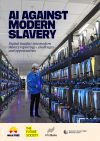Digital Insights into Modern Slavery Reporting
Challenges and opportunities of machine readability
Artificial Intelligence offers a real opportunity to scale our efforts to eradicate modern slavery. One opportunity is the use of AI to ‘read’ the statements produced under mandatory reporting requirements, such as the UK and Australian Modern Slavery Acts, in order to improve transparency.
Reflecting the initial phase of the Artificial Intelligence Against Modern Slavery (AIMS) project, Walk Free, in collaboration with The Future Society, WikiRate, and the Business & Human Rights Resource Centre have published a paper on digital insights into modern slavery reporting, which discusses the challenges and opportunities of machine readability in this area.
Standout findings
Challenges
Gathering and accessing data from modern slavery statements is hampered by the lack of a list of reporting entities – without a list of who should be reporting, it’s difficult to identify the statements. Further issues were linked to scraping text from URLs containing modern slavery statements.
Second, many statements are not in machine readable formats, either as scanned PDFs or other sub-formats of PDF. This increases the difficulties of extracting the data.
Although extensive technological solutions can be used to extract data from modern slavery statements in PDF and HTML formats, establishing transparency and accessibility requirements would reduce the resources needed to do so.
Opportunities
Using structured, machine readable formats across corporate reports would make the information contained in modern slavery statements more easily accessible, which would facilitate data retrieval and allow for better comparisons between companies within and across sectors and countries, and show change over time.
Findings were presented at the Association for the Advancement of Artificial Intelligence (AAAI) Winter Symposium – AI for Social Good track.
Recommendations
For policy-makers
- Publish an up-to-date, comprehensive list of all companies in scope of existing modern slavery legislation and their subsidiaries subject to reporting.
- Keep a single registry where companies must submit their modern slavery statements. These statements must have consistent formatting to ensure easy retrieval.
- Legislate that companies should publish statements in machine readable formats18 to improve comparability and support transparency.
For companies
- Assist governments with keeping an up-to-date, comprehensive list of all companies and their subsidiaries subject to reporting.
- House their modern slavery statements on their homepage, with a URL that includes the reporting year.
- Publish modern slavery statements in a machine-readable format, with infographics and images comprehensively explained in text that fully summarizes and references all information contained within.
Contribute to the project
Conduct research on the Modern Slavery Act project via WikiRate.
Share our Business & Investor Toolkit
Share our Business & Investor Toolkit for companies in taking action to address modern slavery in their supply chains.





